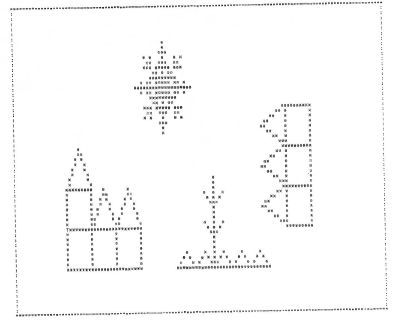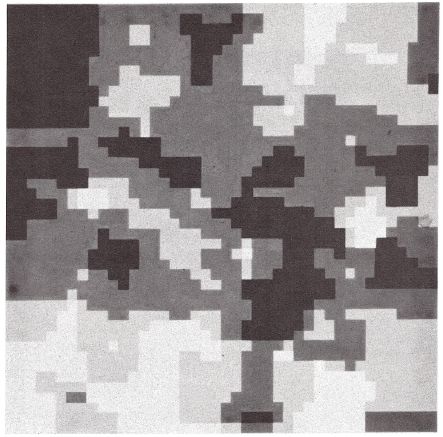HIROSHI KAWANO
WHAT IS COMPUTER ART?

'Simulated Color Mosaic', Hiroshi Kawano
Computer art is the art of computer as an artificial intelligence. A computer can solve an algorithmic problem by digital computing. Therefore, as long as art has an algorithmic procedure, a computer should be able to have its own artistic behavior. Although the aesthetic quality of art seems to have been overstressed in our modern art because of the philosophical influence of epistemological subjectivism since the 18th century, art properly has its generative base on the same human reason as in the case of science as shown in the classic Greek art and Renaissance art. This tells us that art is one kind of logical activity in its essence. Here is the raison d'etre of computer art.
A computer can produce its own works of art by representing the logic of artistic procedure which is hidden in human art. So this representing process is called the simulation of human art by computer. But the computer's ability to simulate art is given by a programmer who lets the computer produce works of art by teaching it the algorithmic procedure of art as a program. This relationship between programmer and computer can be paralleled with the one between parent and his child. A parent teaches his child how to draw a picture, for example, and tries to let him grow up to achieve it by himself. This 'how to draw' is the algorithmic procedure of picture-drawing. In order to do so, the parent must beforehand know the algorithm of picture-drawing which he is now trying to teach his child. The more explicitly he knows and can teach the algorithm, the better the drawn picture of his child will become; that is, the quality of the picture his child drew depends only upon the quality of the algorithm the parent had possessed already and taught his child. The role of a programmer in computer art seems to be similar with this parent's role.
Thus a computer artist should be a programmer who can teach his computer to produce works of art by itself, and furthermore know about the digital computing behavior of his computer in detail. It is never a computer artist, but a computer itself that produces works of art; a computer artist only helps his computer acting as a programmer. It looks as if God controlled a human artist as the creator who had programmed the activity of a human artist. In this meaning, the computer art should not be confused with a style or a school of the modern art using a computer as an innovative tool of an artist who has been tired of traditional techniques of art. As the latter usually seems to be called 'computer art,' I would like to call the former art of computer 'art computer.'

'Art computer' has an artificial creativity corresponding to the level of the program given by a programmer and behaves by the control of a program. This means only the logic of the structural procedure controls composing the required work from data after generating them automatically. It never means that the control results from the data themselves which are necessary to determine the sensuous surface of the finally completed work. Therefore, art computer has the programmed tendency of generating many possible compositions with various modifications in general, and the freedom of selecting an unique work among them according to the program and its input data. This large possibility of production and the variability of the final image an 'art computer' produces is surely the key of its artificial creativity.

As mentioned above, an 'art computer' cannot simulate a human art until the algorithm of art is found and described as a program. But this algorithm of art can be made clear only by scientific aesthetics. In this meaning, the work of 'art computer' is an experimental product of scientific aesthetics. Only the new scientific aesthetics which has replaced the old traditional aesthetics can provide an effective method of programming for 'art computer' because the algorithm, that is the digital computing logic of art, can be cleared up only by scientific aesthetics. Here is a favorable cooperation of art and science which can surely be found in the mature period of art history. Thus, the ability of 'art computer' to produce works with a high artistic quality depends on the degree of understanding of human art in scientific aesthetics. That is, the praxis of 'art computer' is connected tightly with the science of human art.
The computer artist as a programmer should not be a so-called artist who has a sense instead of a reason, but be a scientist of art with logical thinking for whom a rigorous stoicism against beauty is necessary. He may only program for his 'art computer,' and the 'art computer' will produce its works following the given program. In this meaning, just an art computer should be called artist, and a so-called computer artist is not an artist, but a teacher of an 'art computer.' Let's call the teacher of artist (= 'art computer') meta-artist, then it is this meta-artist that is truly needed for an 'art computer.'
Lastly, how can such an algorithmically produced work as mentioned above possess its aesthetic quality? This answer must be obtained from an 'art computer' itself! We cannot feel even another man's human feeling, much less computer's feeling! The works of 'art computer' would show such an aesthetic quality as beautiful, sentimental, comic etc. only for the appreciator with an empathy to it. However, this philosophical problem now doesn't seem so instructive for our 'art computer.'
Tokyo, Japan
September 1975
Return to Table of Contents | Previous Section | Next Section

